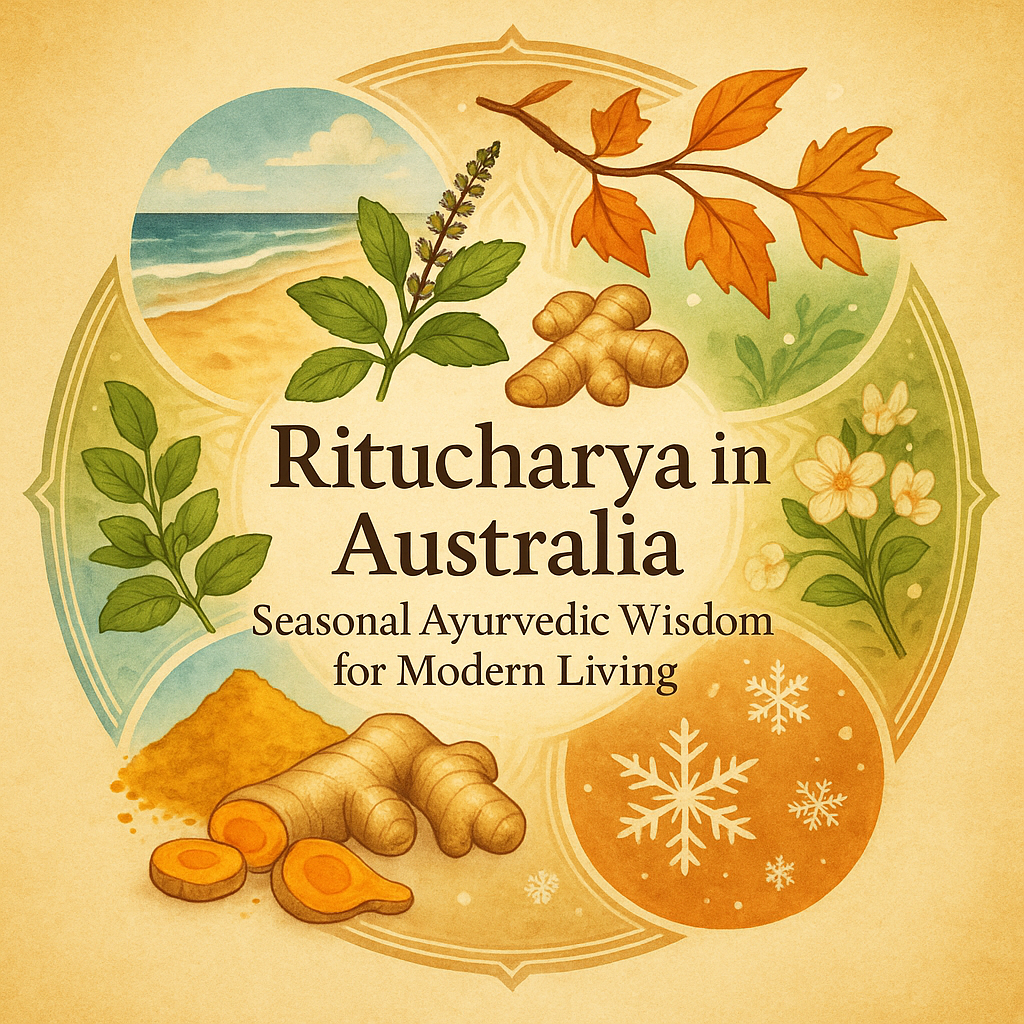In a world increasingly plagued by lifestyle-related disorders, Ritucharya—Ayurveda’s ancient science of seasonal living—offers a timely and powerful framework for preserving health. Traditionally based on the six Indian seasons, Ritucharya prescribes specific lifestyle and dietary adjustments to maintain dosha balance and prevent disease. But how can we apply this wisdom in Australia, where the seasons follow a different rhythm?
Let’s explore how to integrate the six Ayurvedic ritus into Australia’s four-season climate, enabling a modern, mindful approach to well-being through seasonal adaptation.
Mapping Ayurvedic Ritus to Australian Seasons
| Ayurvedic Season | Period (India) | Closest Match in Australia | Australian Calendar |
|---|---|---|---|
| Shishira (Late Winter) | Mid-Jan – Mid-Mar | Late Summer / Early Autumn | Feb – Mar |
| Vasanta (Spring) | Mid-Mar – Mid-May | Autumn | Apr – May |
| Grishma (Summer) | Mid-May – Mid-Jul | Winter | Jun – Jul |
| Varsha (Monsoon) | Mid-Jul – Mid-Sep | Late Winter / Early Spring | Aug – Sep |
| Sharata (Autumn) | Mid-Sep – Mid-Nov | Spring | Oct – Nov |
| Hemanta (Early Winter) | Mid-Nov – Mid-Jan | Summer | Dec – Jan |
This mapping helps apply Ayurvedic seasonal regimens in Australia by aligning the dosha influences, diet, and lifestyle of each ritu with local climatic patterns.
Australian Seasonal Ritucharya
1. Summer (Dec–Feb) – Hemanta Ritu Equivalent
- Equivalent Ritu: Hemanta (Early Winter, India)
- Climate: Hot, dry (inland) or humid (coastal); long days, intense sunlight
- Dominant Dosha: Kapha begins to accumulate
- Digestive Fire (Agni): Strong
- Focus: Nourishment and strength-building.
Goal: Nourish the body and build strength during high Agni
Recommended Diet
-
Tastes: Sweet, salty, sour (Madhura, Lavana, Amla)
-
Foods:
-
Warm, unctuous meals: sesame, wheat, rice, ghee, jaggery, urad dal
-
Milk and milk products (if tolerated), meat soups (for non-vegetarians)
-
Ginger, garlic, long pepper (Pippali)
-
-
Avoid: Dry fasting, cold and light foods, excess raw salads
Lifestyle Tips
-
Daily Abhyanga (oil massage) with sesame or mustard oil
-
Moderate exercise in the early morning
-
Sun exposure during mild hours; avoid peak heat
-
Clothing: Light layers, protect from cool nights or air conditioning
-
Bedtime by 10 PM to support strength-building sleep
Supportive Herbs
-
Ashwagandha (energy and strength)
-
Guduchi (general immunity)
-
Haritaki (digestion)
2. Autumn (Mar–May) – Vasanta & Shishira Ritu Blend
- Equivalent Ritus: Vasanta (Spring) + Shishira (Late Winter)
- Climate: Mild to cool, dry and windy; falling leaves
- Dominant Dosha: Kapha aggravated, Vata accumulates
- Digestive Fire (Agni): Weakened
- Focus: Detoxification and Kapha reduction.
Goal: Detox and reduce accumulated Kapha
Recommended Diet
-
Tastes: Bitter, pungent, astringent (Tikta, Katu, Kashaya)
-
Foods:
-
Barley, millet, buckwheat, lentils, mustard greens
-
Leafy greens, honey, ginger tea
-
Spices: black pepper, turmeric, cumin, ajwain
-
-
Avoid: Cold dairy, sweets, fried and oily foods
Lifestyle Tips
-
Daily exercise to stimulate Kapha removal
-
Udvartana (herbal powder massage) to reduce heaviness
-
Early spring cleansing (Vamana or Panchakarma if supervised)
-
Wake up before sunrise and avoid daytime naps
Supportive Herbs
-
Trikatu (drying and metabolic stimulant)
-
Tulsi (respiratory support)
-
Musta (digestion)
3. Winter (Jun–Aug) – Grishma Ritu Equivalent
- Equivalent Ritu: Grishma (Indian Summer)
- Climate: Cold, dry or damp (region dependent), short daylight
- Dominant Dosha: Vata aggravated, Pitta accumulates
- Digestive Fire (Agni): Weakened
- Focus: Hydration, cooling, and Pitta management.
Goal: Protect digestion and balance Vata-Pitta
Recommended Diet
-
Tastes: Sweet, bitter, astringent (Madhura, Tikta, Kashaya)
-
Foods:
-
Warm, moist, grounding meals: soups, stews, ghee, root vegetables
-
Oats, rice, mung dal, cinnamon, nutmeg, dates
-
Drink warm water or fennel-coriander tea
-
-
Avoid: Cold drinks, raw food, spicy/sour/salty excess
Lifestyle Tips
-
Warm oil massage (Abhyanga) to calm Vata
-
Keep warm: layers, woollens, head and feet covered
-
Stay indoors during cold wind or rain
-
Gentle yoga or restorative movements
Supportive Herbs
-
Dashamoola (Vata support)
-
Triphala (digestive cleanse)
-
Licorice root (mucosal protection)
4. Spring (Sep–Nov) – Sharata & Varsha Blend
- Equivalent Ritus: Sharata + Varsha (Autumn + Monsoon)
- Climate: Warming days, moisture in air, blooming plants
- Dominant Dosha: Pitta aggravated, Kapha reducing
- Digestive Fire (Agni): Variable
- Focus: Pitta pacification and immunity support.
Goal: Cool the body, eliminate residual Pitta, prevent spring allergies
Recommended Diet
-
Tastes: Sweet, bitter, astringent (Madhura, Tikta, Kashaya)
-
Foods:
-
Cooling, detoxifying foods: pomegranate, amla, asparagus
-
Light grains (quinoa, barley), green vegetables, ghee
-
Herbal teas: mint, coriander, licorice
-
-
Avoid: Fermented, spicy, oily, and sour foods
Lifestyle Tips
-
Sleep by 10 PM; avoid staying up late
-
Avoid overexposure to direct sunlight
-
Take moonlight walks for cooling
-
Purgation (Virechana) or mild detox, especially if Pitta symptoms present
Supportive Herbs
-
Shatavari (Pitta pacifier, female tonic)
-
Guduchi (immune support)
-
Neem (skin and liver support)
Adapting Ritucharya to the Australian Context
While Ayurveda traditionally recognises six seasons, Australia’s four-season cycle requires regional and intuitive adaptation. The key lies in understanding local climate rather than strictly following the Indian calendar.
Tips for Implementation:
-
Start seasonal adjustments 2–3 weeks early to ease transitions.
-
Observe your environment—changes in daylight, temperature, and mood.
-
Eat locally and seasonally, guided by Ayurvedic rasa (taste) principles.
-
Use Ayurvedic self-care tools like oil massage, cleansing, and herbal teas.
-
Personalise for your prakriti (individual constitution) with guidance from an Ayurvedic practitioner.
Modern Validation of Ancient Wisdom
Scientific research increasingly supports Ritucharya’s principles:
-
Chronobiology confirms seasonal changes in metabolism and immunity.
-
Microbiome studies show seasonal shifts in gut flora, aligning with Ayurvedic dietary changes.
-
Thermoregulation research validates changes in appetite and strength across seasons.
By syncing lifestyle habits with Australia’s seasons through the lens of Ritucharya, individuals can build resilience, improve digestion, and prevent lifestyle disorders.
Conclusion
Ritucharya isn’t just ancient advice—it’s a dynamic, climate-responsive system. In Australia, where seasonal patterns differ from India’s, this wisdom still holds strong when adapted mindfully. By listening to the body, observing nature, and honouring seasonal rhythms, Australians can access Ayurveda’s full healing potential—right where they are.





